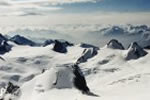


 |
 |
 |
As a glacier moves, particularly a warm glacier, it causes erosion of the underlying surface. However, ice doesn't seem as if it should be a particularly effective material for wearing away hard rocks, so how do glaciers manage to produce such large erosional features?
Material from underlying bedrock or sediment is picked up by the glacier and 'held' in the ice as it moves. Material falling onto the surface (often the result of freeze-thaw activity, or frost shattering, on the surrounding rock walls) is also transported, and often finds its way down through crevasses to the base of the glacier. Material held within the glacier is called 'englacial moraine'. It is this material trapped in the ice, that allows the glacier to erode its surroundings.
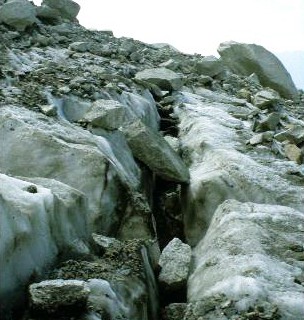
With it's load of abrasive rock fragments, the base of the glacier acts like a belt sander, scraping across the rock, eroding it, producing characteristic erosional features, and creating a supply of material that leads eventually to the formation of depositional features as well. This scraping process is called Abrasion.
Occasionally, a moving glacier may become stuck on its bed. This occurs when for some reason a reduction in pressure causes liquid water to freeze, attaching the moving ice to the bedrock. As the ice continues to move an immense pulling force is applied to the attached rock which may then fracture and be plucked from its position.
The range of size of particles that can be carried by a glacier is tremendous, ranging from very fine, ground up rock termed rock flour to massive boulders.
Rock flour is so prevalent in the meltwater of some glaciers that the water is unsafe to drink. This is especially so in areas where the rocks contain high concentrations of mica, such as the Garnet Mica Schist of Svartissen. To avoid stomach problems it's advisable to use a hose to drink water from below the surface of streams, since the majority of the mica flour floats in the upper few centimetres of the water.
At the other end of the scale a glacier can carry rocks hundreds of metres in diameter. These are usually from sources on the valley walls and fall onto the glacier rather than being plucked out of the underlying bedrock.
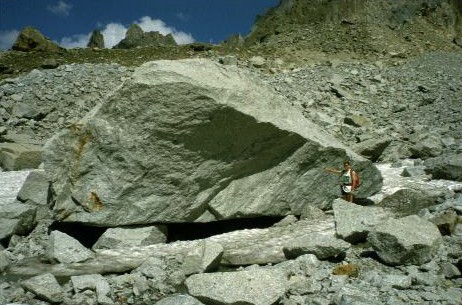
Although the surfaces of glaciers can seem to consist of nothing but rock debris, most of the debris in a mature glacier is concentrated near its base. In fact basal ice may consist of only one part ice to every nine of sediment.
The reason that the surfaces often seem so well coated in moraine are two fold. Firstly, the surface is the obvious place for debris from the valley walls to accumulate, and secondly, the surface is subjected to insolation and melting.
As the surface warms up, ice melts and runs off via a network of surface streams. Much of the larger intra-glacial debris that drops out of the melting ice remains on the surface for a period of time. Some of this material will find it's way down through crevasses and holes to aid the erosion of the bedrock, the rest will be covered by winter snows, possibly to appear again in another summer melt. During the summer the effects of melting can produce interesting features. Small dark rocks can warm up faster than the surrounding ice, and melt their way into the surface of the glacier, where as larger rocks, especially light colours ones, may be slow to warm up and thus protect the ice below them. This leads to the formation of bumps and tables with a rocky surface and an ice column beneath.
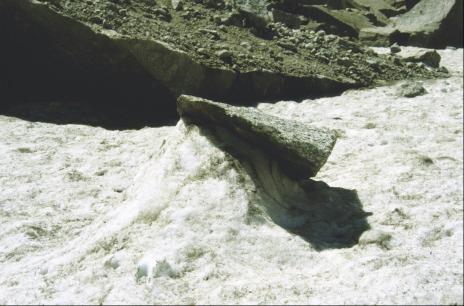
Running water is very common on and within glaciers. Snow and ice that melts on the surface of the ice, or is generated by melting at the base, commonly forms extensive channels on, within, or beneath the glacier. This flowing water also transports a considerable amount of sediment to the snout of the glacier.
Near the glacier snout debris also tends to move upwards along shear planes within the ice; curved surfaces which are due to the faster movement of ice above each plane relative to the ice below the plane, reversing the general burying of debris.
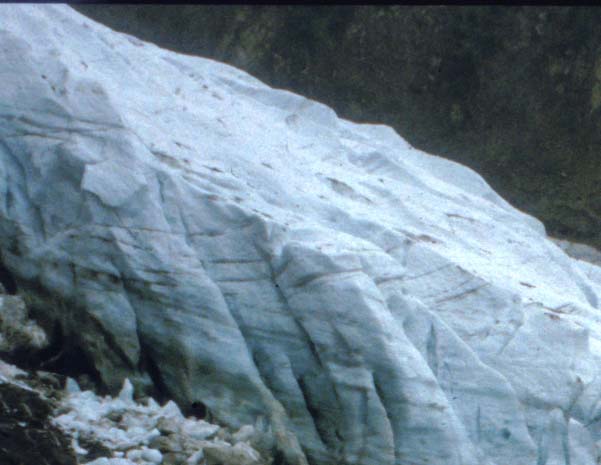
We value
your ideas and suggestions. Please contact the
maintainer of this site.
This page
can be found at: http://www.geography-site.co.uk
Last update to
this statement was on:
February 23, 2006
© Copyright Geography Site